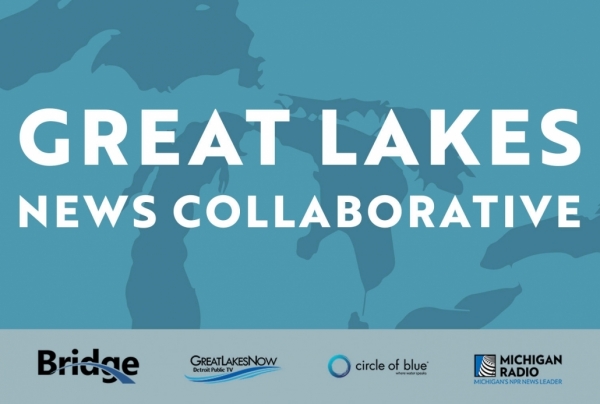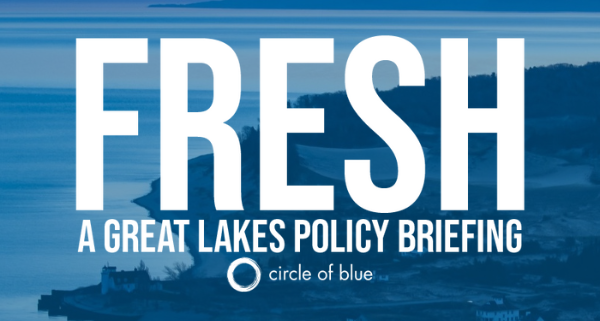Fresh, January 23, 2024: Proposed Bill Would Authorize $200 Million for Great Lakes Mapping Project
January 23, 2024
Fresh is a biweekly newsletter from Circle of Blue that unpacks the biggest international, state, and local policy news stories facing the Great Lakes region today. Sign up for Fresh: A Great Lakes Policy Briefing, straight to your inbox, every other Tuesday.
— Christian Thorsberg, Interim Fresh Editor
This Week’s Watersheds
- A bipartisan bill proposed by Michigan state representatives would authorize $200 million to conduct high-resolution mapping of lake beds in the Great Lakes.
- Amidst an icy winter, the U.S. Coast Guard needs more than $3 billion to maintain icebreaking services on the Great Lakes.
- In Minnesota, a 30-year report on the Upper Mississippi River shows both long-term progress and recent pollution concerns.
- The EPA will soon decide if a toxic channel on Chicago’s Southwest Side should be cleaned up, and who would be responsible.
A bill introduced in the Indiana General Assembly seeks to shrink wetland protections, while another would offer tax breaks to help preserve them.
“We want people to be encouraged to preserve these mature wetlands. A mature wetland even of a small size will do more good cleaning the water, keeping it clean, making things better for all of us.” — Indiana State Senator Sue Glick.
Two competing bills are working their way through the Indiana state legislature this month — one which seeks to reduce wetland protections, and another that incentivizes them.
House Bill 1383 would change the way wetlands are classified, dropping many ecosystems out of the state’s most-protected Class 3 status. The proposed legislation comes on the heels of a 2021 bill, which had already made more wetland ecosystems vulnerable to development and pollution.
Meanwhile, Senate Bill 246 would give the Indiana Department of Natural Resources the ability to classify certain lands as “wildlands,” and offer both land developers and homeowners tax incentives to keep such habitat intact.
According to Indiana Public Radio: “Both bills passed committee. The House bill now moves to the full House for consideration, while the Senate bill will have to go through the Appropriations Committee first.”
Fresh from the Great Lakes News Collaborative

- U.S. defense department to install two new groundwater treatment systems for PFAS in Oscoda — Michigan Radio
- Great Lakes policy advocate calls out Illinois for intransigence on invasive carp solution — Great Lakes Now
- Turtles return, 10 years after Kalamazoo River oil spill — Bridge Michigan
The Great Lakes News Collaborative includes Bridge Michigan; Circle of Blue; Great Lakes Now at Detroit Public Television; and Michigan Radio, Michigan’s NPR News Leader. We work together to produce news and information about the impact of climate change, pollution, and aging infrastructure on the Great Lakes and drinking water. This independent journalism is supported by the Charles Stewart Mott Foundation. Find all the work here.

Project Mapping Lakebeds Receives Bipartisan Support in Proposed Bill
According to the Great Lakes Observing System, only 15 percent of the Great Lakes’ lake floor has been mapped at depth and in detail, leaving a wide gap for potential research and in scientists’ understanding of earth’s largest freshwater system.
Michigan representatives Debbie Dingell (D) and Lisa McClain (R) have introduced a bill to seize this opportunity: The Great Lakes Mapping Act, which would authorize $200 million to be used to “enable exploration, yield discoveries, and enrich Great Lakes knowledge.”
If approved, the National Oceanic and Atmospheric Administration (NOAA) would lead high-resolution bathymetric mapping of lakebeds, the data from which would be made available to the public. According to WXYZ-Detroit, per the terms of the bill, the entire project would need to be completed before New Year’s Day, 2030.
In the News
Icebreaking: According to a new U.S. Government Accountability Office report, the Coast Guard requires more than $3 billion to continue providing icebreaking services throughout the Great Lakes. Currently, 33 U.S. Coast Guard vessels clear ice from frozen channels, harbors, and other waterways to make way for commercial routes and other essential travel. They maintain a 95 percent ice clearance goal, a high bar with expensive consequences — “on average, for every one percent increase in the average ice coverage in the Great Lakes region there was an associated one percent decrease in total Great Lakes cargo volume,” Cleveland.com reports.
Upper Mississippi River: A recently published report on the river, spanning from 1989 through 2018 in Minnesota, offers both good and bad news on the ecosystem’s health, Minnesota Public Radio reports. The good news: Compared to a century ago, when Twin Cities’ residents dumped raw sewage, chemicals, and sawdust directly into the Mississippi River, the waterway has recovered remarkably well. But recent research also shows the rise of new pollutants, including spikes in both chlorine (washed into the river as road salt) and nitrogen (a component of agricultural fertilizer).
Looking Ahead
Chicago Sanitary and Ship Canal: Within the next month, the EPA is expected to decide if a “foul-smelling” canal and channel, contaminated with toxic chemicals and heavy metals, will be cleaned up — and who would be responsible, the Chicago Sun Times reports. The waterway is located in Chicago’s Little Village neighborhood on the city’s Southwest Side. Considered an environmental justice neighborhood, residents there have “been historically burdened with excess pollution and other social stresses” for decades. Residents and petitioners who have been pleading for action for years say the blame lies with the Metropolitan Water Reclamation District of Greater Chicago, who helped create the channel more than a century ago and are responsible for treating sewer wastewater and stormwater. The district denies responsibility, and says they have also been advocating for the area’s cleanup for years.
Upcoming Events
January 25 — 2024 Ontario Phragmites Working Group Meeting — learn more
January 29-30 — The Stewardship Network Conference — learn more
January 30 — Introduction to Lakes Online — learn more
Other News
Ontario’s Grasslands: A push to restore grasslands — lost to development and farming — in southern Ontario is gaining momentum, as residents learn of the habitat’s benefits for water, wildlife, and people, the Narwhal reports.
Michigan Mollusks: For the first time ever, Michigan’s Department of Natural Resources has hired a scientist specializing in mussels and clams, and launched a two-year research project to collect data about mollusks and freshwater throughout the state, Michigan Radio reports.
Christian Thorsberg is an environmental writer from Chicago. He is passionate about climate and cultural phenomena that often appear slow or invisible, and he examines these themes in his journalism, poetry, and fiction.






Leave a Reply
Want to join the discussion?Feel free to contribute!